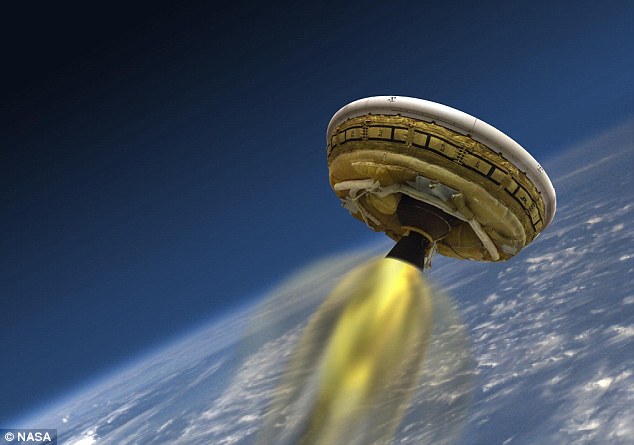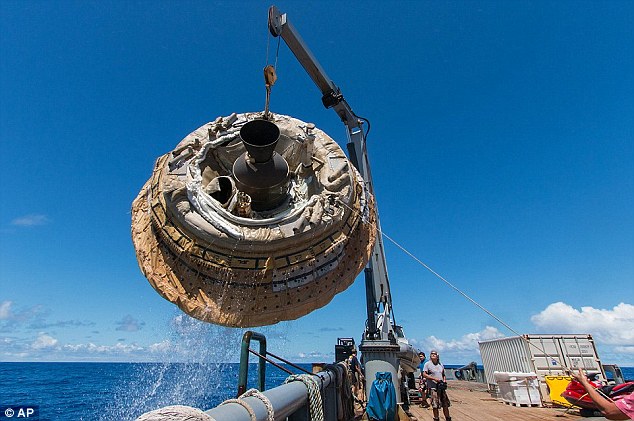NASA tested the 'flying saucer' to block heat for the Martian landings
According to the latest science on the Daily Mail, NASA will continue new tests this year with the LDSD "flying saucer" as a heat shield in space.
NASA tested the new flying saucer as a heat shield in space
NASA's experimental 'flying saucer' as a 'heat shield ' in space, helping the first astronauts to drop to Mars surface will not have to use conventional heat shields or umbrellas. as used before.
Under the impact of the Martian atmosphere, 'flying saucers' can be greatly inflated, reducing its landing speed. This is a low density ultrasonic reducer (LDSD) . In June, Nasa will conduct a test with this latest breakthrough technology. This is one of the important inventions that support the journey to set foot on human Mars.

NASA's flying saucer plays a new role as a heat shield in space
From 22:00 March 30, 2015 to 11:00 on March 31, 2015 - Vietnam time, NASA will conduct a test at the California Prop Propulsion Laboratory before the "flying saucer" is shipped to Hawaii. This event is broadcast live on Ustream channel, viewers can ask questions on Twitter. After the California test, NASA's "flying saucer" will be brought into space by a US Navy missile on Kauai Island, Hawaii, in June.
NASA officials said: 'During the process of performing missions on Mars, the LDSD flying saucer will test new breakthrough technology capable of withstanding large loads, so that it can safely land on the surface of Mars, or any other planet, including the Earth, despite being affected by the atmosphere. Moreover, the new technology also allows the "flying saucer" to get closer to the ground, as well as help it land conveniently even at any height. "

NASA's flying saucer-shaped test will take place in Hawaii
The LDSD is a large device with a width of about 4.6 meters and a weight of up to 3,200kg that can help "fly " with the atmosphere on Mars. The Earth has a moderately thick atmosphere, so people can land easily by popular skydiving. But the atmosphere on Mars is much thinner, so the parachute that supports the landing spacecraft needs to be larger in size to create a sufficiently strong force to land safely. The new equipment system is designed to be able to load a large self-propelled vehicle on the surface of Mars.
Typically, the Curiosity self-propelled vehicle, it used to require a special landing method because of its large size, but this technology was not applied yet. Instead, for self-propelled robots to land safely on Mars's surface, NASA developed a grounding mechanism using Sky Crane with the task of hugging the autonomous robot to leave the spacecraft to prepare for approaching the surface of Mars, then launching an anti-ship missile to let the autonomous robot land smoothly, then Sky Crane will move.
Four overall tests with LDSD will take place on the island of Hawaii, Kauai in June, before scientists decide whether to use it for future Mars discovery missions. In June 2014, LDSD was tested and achieved some success.The LDSD is a new innovative method used in research tasks with large payloads on Mars and other objects in the solar system. Two test flights are expected to be deployed next year.
- Detecting millions of years old flying saucer of aliens?
- NASA landing gear gains strange pulses on Mars
- The flying saucer
- New flying saucer was born in America
- Flying saucer-like objects fell into the American desert
- NASA tested a UFO-like spacecraft
- The Russian Air Force will be equipped with flying saucers
- The FBI revealed documents about UFO landings
- Flying saucers and American presidents
- Suspicious objects are floats floating 10 hours in the sky of Shanghai
- Huge 'flying saucer' in the universe
- NASA tests landing on Mars with
 Van Allen's belt and evidence that the Apollo 11 mission to the Moon was myth
Van Allen's belt and evidence that the Apollo 11 mission to the Moon was myth The levels of civilization in the universe (Kardashev scale)
The levels of civilization in the universe (Kardashev scale) Today Mars, the sun and the Earth are aligned
Today Mars, the sun and the Earth are aligned The Amazon owner announced a secret plan to build a space base for thousands of people
The Amazon owner announced a secret plan to build a space base for thousands of people